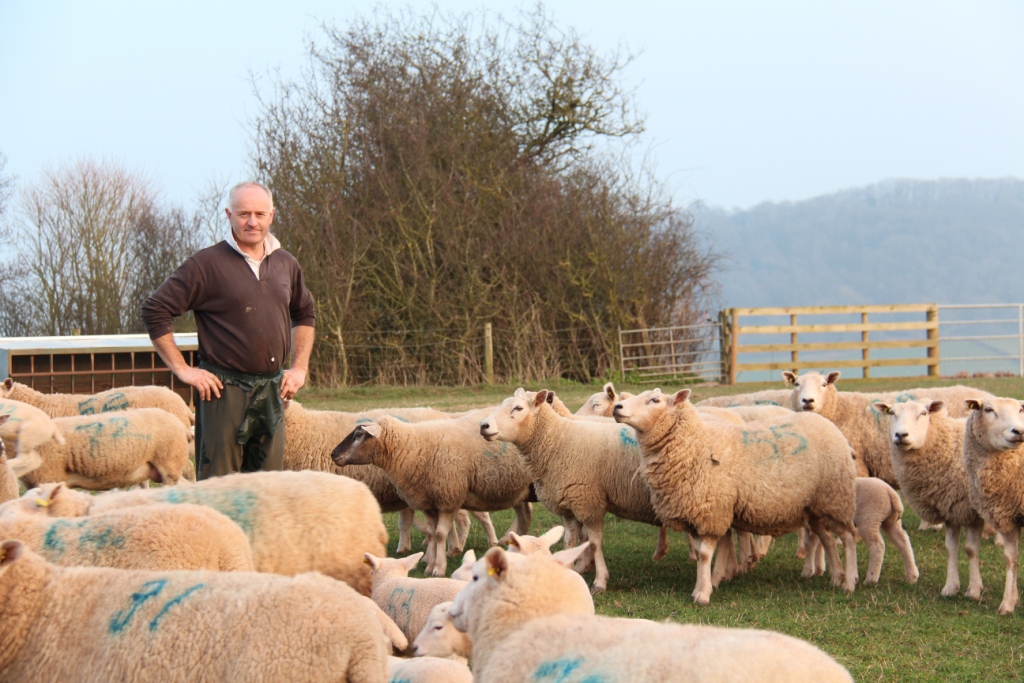
Worcestershire sheep farmer trials premier protein pellets from JG Animal Health to measure impact on rumen development. With grain prices at levels below the cost of production one grower has been investigating opportunities to utilise home-grown cereals to better advantage. Based in Abberley Worcestershire Marcus Bullock has been exploring the economics of supplement feeding lambs in his performance recorded Lleyn flock with home grown barley and oats.
The long-established Lleyn breeding flock has been developed on a forage-based system over a period of 25 years, and short-term leys in the arable rotation are utilised in conjunction with improved permanent pasture to produce pure bred breeding stock, both males and females, with the balance of production going directly to slaughter. Mr Bullock has long been aware that days to slaughter has the most direct influence on flock profitability, but in line with the long-term objective of producing breeding stock essentially from forage, he was reluctant to embark on full-scale creep feeding of lambs to further enhance daily live weight gains up to weaning.
Research during the autumn and winter of 2014 suggested that low-level supplementation of whole cereal grains given to young lambs up to weaning age (3 to 4 months), could subsequently stimulate rumen development – therefore enhancing that animal’s ability to utilise highly digestible forage (namely spring grass), with the potential for improved daily live weight gains. With performance-recording at the very heart of the development of this flock, it was felt that the possibility of further expressing the genetic potential of the progeny was worthy of further experimentation.
The flock used whole grain 3-in-1 feeders during 2013 and 2014 to provide low-level supplementation to out-wintered ewes prior to lambing. In-lamb ewes have used the feeders without hesitation, visiting them on a regular basis in the same way they would visit a lick bucket or feed block. Careful adjustment of the feeder settings has enabled intakes to be limited to less than 150g/day, which has meant that twin-bearing ewes could be supplemented for as little as 10p per week at current cereal prices.
In addition, ewes have experienced less metabolic disorders with lower rates of pregnancy toxaemia and hypocalcaemia. Where ewes in the later stages of pregnancy have required a higher level of protein supplementation, pellets have been included in the mix. These have been specifically formulated to balance the conserved forage available, both in terms of minerals and vitamins, and have been produced in a 3mm hard pellet which allows them to flow through the whole grain feeders at the same rate as the barley and oat grains, without separation.
Having not supplemented lambs before with whole grain, Mr Bullock was unsure as to how quickly lambs would investigate the blend – however, where February lambed ewes were being trough-fed with a whole-grain supplement, he quickly noticed lambs at 3 to 4 weeks of age were taking an interest in the mix, and nibbling at the whole grains. Similarly, lambs born to March lambing ewes were taking interest(at a similar age) in the post-lambing supplement available to their mothers from whole grain feeders. It was decided to introduce the whole grain ration at around 6 weeks of age, either via conventional free-access lamb creep feeders, or by bringing down the shutters on the whole grain feeders - therefore removing access to them for the ewes but still allowing lambs to feed.
The amounts fed have been carefully recorded, with the intention of removing the supplementation shortly after weaning (at approximately 14 weeks of age), in line with the availability of silage aftermaths for lambs to graze post-weaning. The 50:50 blend of barley and oats has provided a lower starch and higher fibre supplement preventing the risk of acidosis and there has been little sign of whole grains passing through the lambs’ digestive system and being wasted.
It would appear that lambs have used the feeders sensibly, not expressing a ‘luxury’ intake for the feed, with average intakes (as fed) at less than 300 grams per day over the 60-day period, with maximum intakes peaking at around 400 grams per day pre-weaning. Since removal, lambs have continued to flourish on aftermath grazing, with no outward sign of any digestive setback, and continuing to perform at pre-weaning daily live weight gains. The home-mixed ration has been formulated to give 16% CP and 11 ME (on a dry-matter basis) and is currently costing £ 175/tonne. Daily live weight gains appear to be between 20 and 30 grams per day higher (on average) than the figures recorded for both February and March born lambs in 2014, providing an extra 2kg live weight at the time of weaning, for an additional cost of approximately £ 3 per lamb weaned.
For this specific flock, the objective is to attempt to maximise the genetic potential of the lambs that are to be considered for retention or sale as breeding sheep, but in the current economic climate it is considered to be more important than ever that those lambs not to be selected for breeding achieve slaughter weights at the earliest opportunity. Mr Bullock is extremely pleased with the way the experiment has turned out and has been pleasantly surprised at how quickly lambs found the whole-grain palatable, without the problems associated with luxury intake and resultant acidosis.
“For this particular flock, we have to continue to improve the utilisation of grass, which is still our cheapest feed” said Mr Bullock. “I believe this short-term, low-level supplementation to enhance rumen development in our growing lambs will help us to get the very best performance from our pasture, at an acceptable extra cost, utilising home-grown cereals for ultimate provenance”.
Mr Bullock concludes; “This technique, used alongside rotational paddock grazing, allows us to achieve the maximum live weight gains at the highest stocking rates - this in turn provides us with a very useful increase in kg of lamb produced per unit area, helping to offset the current depression in both lamb and cereal commodity prices”.
